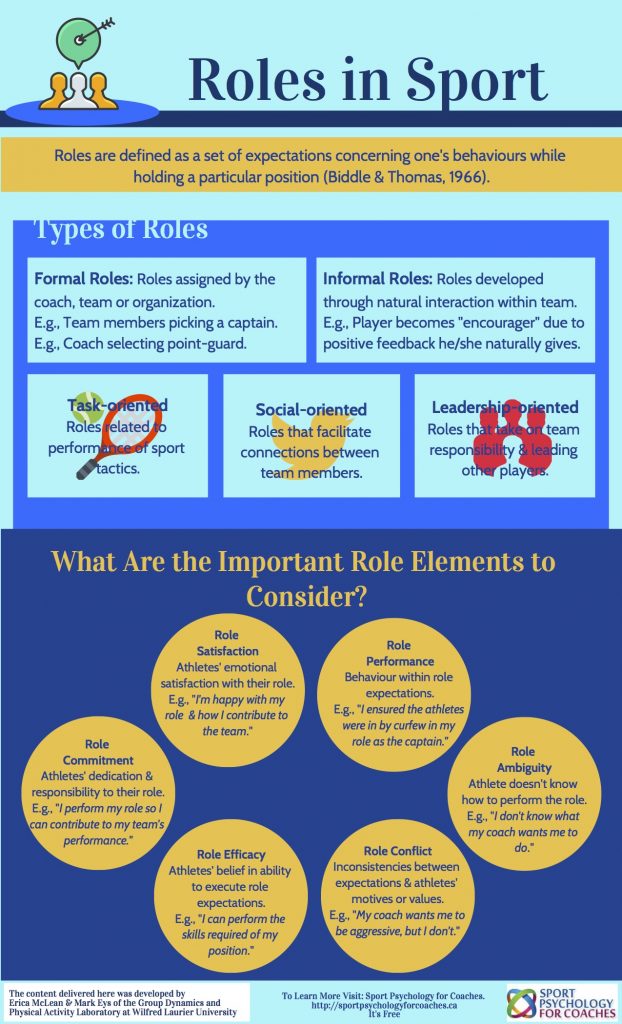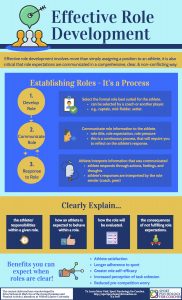
Within every group environment, roles are defined as a set of expectations concerning one’s behaviors while holding a particular position1. Roles may contribute to both individual perceptions (e.g., satisfaction, cohesion) and team performance2. As coaches, it is important to ensure you are implementing and fostering positive roles within your team for optimal outcomes. Although the idea of roles may seem simple, the classification, development, and athletes’ experiences regarding their role responsibilities can be quite complex. For further information about the classification of roles and important elements of roles to consider, see the “Roles in Sport” infographic.
Developing Roles
There are three main steps for coaches to consider when structuring roles within their team: (a) developing roles, (b) effectively communicating roles, and (c) ensuring that athletes fully understand their roles3. The Role Episode Model4 explains how formal role expectations and pressures are developed and communicated. In brief, this model suggests that the coach exerts role expectations and role pressures onto the athlete. The athlete will interpret these expectations and pressures, and this will elicit a response by the athlete, that can take several forms, including how an athlete feels, behaves, and thinks about their role responsibilities5.The way the role is both communicated by the coach and how it is perceived by the athlete can be influenced by factors such as personality, expectations, or personal values. For further information regarding role development see the “Effective Role Development” infographic.

Summary
Coaches need to be aware of the role expectations and pressures they are placing on their athletes. Make sure to focus on communicating clearly to your athletes in terms of what you expect from them as a player. By doing so, it is more likely your athlete will experience positive role elements such as role clarity, role satisfaction, and role efficacy. Furthermore, it will be less likely for problematic roles and intrusive role perceptions (e.g., role conflict) to be present within the team that can diminish performance. It is recommended that coaches strive to properly communicate, and reinforce, formal and informal roles that contribute to overall team functioning.
Click the Following Link to Learn About Athlete Roles:
Introduction to Roles within Sport Groups
Use These Tools to Implement the Idea of Athlete Roles with Your Athletes
Goal Setting Page Survey Questions
To help us improve the content and format of this resource, please take a minute to share your thoughts about the information on this page using the scale provided.
References & Key Readings
The content delivered here was developed by Erica McLean & Mark Eys of the Group Dynamics and Physical Activity Laboratory at Wilfred Laurier University. https://www.wlu.ca/academics/faculties/faculty-of-science/faculty-profiles/mark-eys/group-dynamics-physical-activity-lab.html
***Denote key readings in the field of athlete roles
- Biddle, J. B., & Thomas, E. J. (1966). Role theory: Concepts and research. New York: John Wiley & Sons, Inc.
- Beauchamp, M. R., Bray, S. R., Eys, M. A., & Carron, A. V. (2003). The effect of role ambiguity on competitive state anxiety. Journal of Sport and Exercise Psychology, 25, 77-92.
- Eys, M. A.,Patterson, M. M., Loughead, T. M., & Carron, A. V. ( 2005). Team building in sport. In D. Hackfort, J. L., Duda, & R. Lidor, R. (Eds). Handbook of research in applied sport and exercise psychology: international perspectives. (pp. 526-227). Morgantown, WV: Fitness Information Technology, Inc.
- Eys, M. A., Carron, A. V., Beauchamp, M. R., & Bray, S. R. (2005). Athletes’ perceptions of the sources of role ambiguity. Small Group Research, 36, 383-403.
- Eys, M. A., Beauchamp, M. R., & Bray, S. R. (2006). A review of team roles in sport. In S. Hanton, & S. D. Mellalieu (Eds.), Literature reviews in sport psychology (pp. 227-255). Hauppauge, NY: Nova Science Publishers, Inc.

